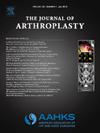Biofilm Formation is Durably Prevented on Pre-Fabricated Antibiotic Cement Spacers Compared to Cobalt Chrome and Polyethylene
IF 3.4
2区 医学
Q1 ORTHOPEDICS
引用次数: 0
Abstract
Background
A 2-stage revision remains the standard for managing chronic periprosthetic joint infection. Despite multiple spacer options, whether a particular one better resists biofilm formation remains unclear. Prefabricated polymethylmethacrylate (PMMA) articulating spacers containing antibiotics and a proprietary pore structure were developed to increase antibiotic elution characterized by a rapid burst phase for the initial one to two days and an extended slow-release phase for > 28 days. This in vitro study determined whether biofilm formation is prevented during the initial rapid burst phase and/or the slow-release phase.
Methods
S. aureus-Xen36 was incubated in 1.5 mL of Luria-Bertani broth with PMMA discs with the proprietary pore structure either with or without gentamycin and vancomycin or with ‘Hoffman style’ positive-control discs (ultra-high molecular weight polyethylene or cobalt-chrome). Nonadherent bacteria were removed by three phosphate buffered saline rinses every 20 to 24 hours. Planktonic bacterial growth in the culture broth and biofilm formation on the discs were measured by colony forming unit (CFU) counting and resazurin reduction assays. Experiments were repeated > four times.
Results
No detectable planktonic bacterial growth or biofilm formation occurred in cultures containing PMMA with antibiotics (≤ 15 CFUs/disc), whereas biofilms formed on PMMA without antibiotics, ultra-high molecular weight polyethylene, and cobalt-chrome (1 × 107 to 4 × 108 CFUs/disc, P < 0.0001). Biofilm formation was confirmed by a 100-fold decrease in sensitivity to vancomycin. To determine whether the antibiotic slow-release phase is sufficient to block biofilm formation, PMMA discs with antibiotics were preeluted for 14 days with multiple saline changes prior to bacterial inoculation. After antibiotic elution, still no detectable biofilms formed on PMMA discs with antibiotics (≤ 15 CFUs/disc, P < 0.0001).
Conclusions
Antibiotic release during both the initial and slow-release phases prevented biofilm formation on PMMA with the proprietary pore structure. This may translate into improved infection eradication rates clinically.
与钴铬合金和聚乙烯相比,预制抗生素水泥垫片可持久防止生物膜形成。
背景:两阶段翻修仍是治疗慢性假体周围关节感染(PJI)的标准方法。尽管有多种垫片可供选择,但是否有一种垫片能更好地防止生物膜形成仍不清楚。预制聚甲基丙烯酸甲酯(PMMA)关节垫片含有抗生素和专有孔隙结构,可增加抗生素的洗脱,其特点是在最初的 1 到 2 天内为快速迸发阶段,在超过 28 天的时间内为延长缓释阶段。这项体外研究确定了在最初的快速爆发阶段和/或缓释阶段是否能防止生物膜的形成:金黄色葡萄球菌-Xen36 在 1.5 毫升 Luria-Bertani 肉汤中与具有专利孔隙结构的 PMMA 盘(含或不含庆大霉素和万古霉素)或 "霍夫曼式 "阳性对照盘(超高分子量聚乙烯(UHMWPE)或钴铬)一起培养。每隔 20 到 24 小时,用磷酸盐缓冲盐水冲洗三次,清除未附着的细菌。通过菌落形成单位(CFU)计数和利马唑啉还原测定法测量培养液中的浮游细菌生长情况和圆片上的生物膜形成情况。实验重复 > 4 次:结果:在含有抗生素(≤ 15 CFUs/disc)的 PMMA 培养物中,未检测到浮游细菌生长或生物膜形成,而在不含抗生素的 PMMA、超高分子量聚乙烯和钴铬合金上则形成了生物膜(1x107 到 4x108 CFUs/disc,P < 0.0001)。对万古霉素的敏感性降低了 100 倍,证实了生物膜的形成。为了确定抗生素缓释阶段是否足以阻止生物膜的形成,在接种细菌之前,用多次生理盐水对含有抗生素的 PMMA 盘进行了 14 天的预洗脱。抗生素洗脱后,含抗生素的 PMMA 盘上仍未形成可检测到的生物膜(≤ 15 CFUs/盘,P 结论):抗生素在初始释放和缓慢释放阶段都能阻止生物膜在具有专有孔隙结构的 PMMA 上形成。这可能会提高临床上的感染根除率。
本文章由计算机程序翻译,如有差异,请以英文原文为准。
求助全文
约1分钟内获得全文
求助全文
来源期刊

Journal of Arthroplasty
医学-整形外科
CiteScore
7.00
自引率
20.00%
发文量
734
审稿时长
48 days
期刊介绍:
The Journal of Arthroplasty brings together the clinical and scientific foundations for joint replacement. This peer-reviewed journal publishes original research and manuscripts of the highest quality from all areas relating to joint replacement or the treatment of its complications, including those dealing with clinical series and experience, prosthetic design, biomechanics, biomaterials, metallurgy, biologic response to arthroplasty materials in vivo and in vitro.
 求助内容:
求助内容: 应助结果提醒方式:
应助结果提醒方式:


